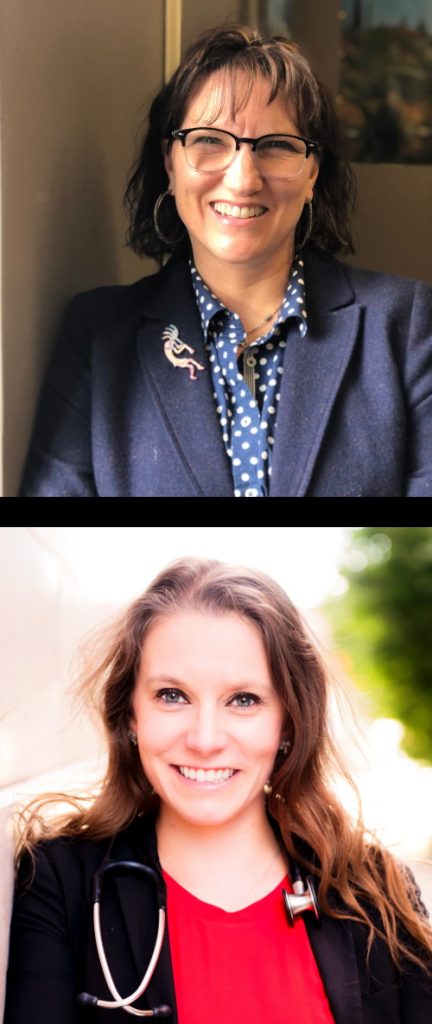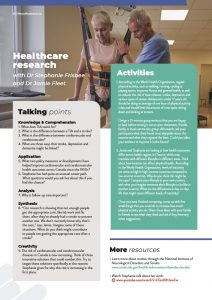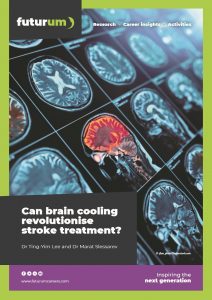How are strokes, dementia and depression linked?
At Western University in Canada, Dr Jamie Fleet and Dr Stephanie Frisbee are collaborating to improve health outcomes for people affected by stroke, depression and dementia.
Talk like a healthcare researcher
Ageing population — a population where the proportion of people over 65 is increasing
Cardiovascular — relating to the heart and blood vessels
Cerebrovascular — relating to the brain and its blood vessels
Dementia — the name for a collection of symptoms that affect memory, thinking, language and behaviour
Ischemic strokes — the most common type of stroke, when a blood clot blocks the flow of blood and oxgyen to the brain
Outpatient — a patient who attends hospital for treatment without staying overnight
Physiatry — a branch of medicine that helps people impacted by disabilities, diseases or injuries to improve their functional ability and quality of life (also known as physical medicine and rehabilitation)
Primary care — the initial, day-to-day healthcare that someone will receive, such as visiting their local health clinic
Stroke — a life-threatening condition that occurs when blood flow to a part of the brain is cut off
Transient ischaemic attack (TIA) — a temporary disruption in the blood supply to part of the brain, which causes stroke-like symptoms
In Ontario, Dr Jamie Fleet and Dr Stephanie Frisbee are studying the health data of people affected by strokes, depression and dementia. Their goals are to find out why these conditions are linked, how treatments can be improved and how health outcomes for these conditions change across different geographical areas.
“Epidemiologic studies, that look at diseases and how they are spread, have shown that these conditions – stroke, depression and dementia – often occur together, and that having one of them increases the chance of having another,” says Stephanie, who is the founder of the Translational Health and Outcomes Research (THOR) Lab at Western University.
The concurrence of these conditions is likely caused by a few different things. Firstly, the permanent, debilitating effects that a stroke can have on someone’s life can lead to them developing depression. Secondly, the loss of blood to the brain during a stroke can either cause or worsen mental illnesses such as dementia. “As well as that, there seem to be common pathways including inflammation and changes to blood flow that affect all these conditions,” explains Jamie, whose work focuses on stroke rehabilitation and prevention.
Nowadays, people are living longer, which increases their chance of having a stroke, and living longer with disabilities. “Finding treatments for dementia and post stroke depression, and preventing future strokes, is important for a variety of reasons, including patient quality of life and healthcare spending,” says Jamie.
If healthcare providers can better understand how and why these conditions occur, they can intervene with preventative care methods that will hopefully stop or slow their development.
Health outcomes
“Since the late 1950s, and with significant advances from the biomedical research and public health communities, we have made huge strides in reducing the burden of cardiovascular and cerebrovascular diseases, including heart attacks and strokes,” says Stephanie. These advances have come from measures such as tobacco control policies to reduce smoking and the development of drugs such as statins, beta-blockers and calcium channel blockers, which treat and reduce important risk factors that lead to heart attacks and strokes.
However, several studies suggest that the risk of cardiovascular and cerebrovascular diseases might be starting to increase again. “A recent study1 from the Global Burden of Disease projected that ischemic strokes will, in fact, increase in Canada between 2020 and 2030,” explains Stephanie.
One of the reasons for this is the ageing population in Canada, but there are other concerning, and preventable, factors too. “Several very important risk factors, including physical activity and fitness, diet and diabetes, are becoming substantially worse in many countries, including Canada,” explains Stephanie. Additionally, access to primary care – such as getting a quick appointment at your local health clinic – is declining in Canada, which is leading to certain high-risk health factors not being picked up before they develop into more serious problems. “Canada does not have an integrated, cohesive electronic healthcare information system,” says Stephanie. This creates further challenges to controlling high-risk health problems.
Tackling the problem
Reference
https://doi.org/10.33424/FUTURUM510
Dr Jamie Fleet’s work involves stroke rehabilitation
© Jamie Fleet
© Monkey Business Images/Shutterstock.com
© metamorworks/Shutterstock.com
Jamie and Stephanie are building upon previous research that assessed the quality of care that patients received after having a stroke. “Our analyses will assess how well patients who have had a stroke or transient ischaemic attack (TIA) receive outpatient, follow-up care designed to control risk factors for a subsequent stroke or TIA. We are also studying how many people who have a stroke or TIA in Ontario go on to develop dementia,” says Stephanie.
Stephanie and Jamie are using a dataset from ICES (formerly the Institute for Clinical Evaluative Sciences), an independent, non-profit research institution in Ontario that looks at health services and outcomes across populations. “This dataset includes data from all over Ontario, so our study will provide a good snapshot of the quality of post-stoke and post-TIA care in the province,” explains Stephanie. Stephanie and Jamie are hoping to divide some of the results by health regions in Ontario, to see how living in a different area of the province affects health outcomes.
Follow-up care
Follow-up care prevents the risk of further harmful conditions developing, ensures patients recover as best as possible, and helps healthcare professionals understand what happened and why. A stroke, for example, is usually a sign of a more advanced underlying disease; follow-up care allows doctors to investigate a situation fully and understand what else might be going on.
It is especially critical to have good follow-up care and support after suffering from a stroke or TIA as there is a significant chance of having a second stroke or TIA. Similarly, one in three people who have a TIA will have a stroke sometime in the future.
Jamie and Stephanie’s findings
“Our research is showing that not enough people get the appropriate care, like lab work and flu shots, after they’ve already had a stroke in order to prevent another one,” says Jamie. “We don’t currently know why that’s the case, but identifying these gaps is a first step to addressing them.”
Jamie and Stephanie’s research is ongoing. “We sincerely hope that our results will highlight the gaps in care that Ontarians are experiencing and that it will be part of the push to make the changes to the healthcare system needed to improve the quality of healthcare in Ontario,” says Stephanie.
With much analysis to come, Jamie and Stephanie are hoping that their future work will lead to improvements of health outcomes for the most amount of people possible.
1 Pu L, Wang L, Zhang R, Zhao T, Jiang Y, Han L. Projected Global Trends in Ischemic Stroke Incidence, Deaths and Disability-Adjusted Life Years From 2020 to 2030. Stroke. 2023 May;54(5):1330-1339. doi: 10.1161/ STROKEAHA.122.040073. Epub 2023 Apr 24. Erratum in: Stroke. 2024 Jan;55(1):e23. PMID: 37094034.
 Dr Stephanie Frisbee
Dr Stephanie Frisbee
Associate Professor, Department of Pathology and Laboratory Medicine
Fields of research: Population health, health outcomes, epidemiology
Dr Jamie Fleet
Associate Professor, Physical Medicine and Rehabilitation
Fields of research: Physiatry, strokes, community health
Western University, Canada
Research project: Improving stroke, depression and dementia outcomes in Ontario
Funder: This programme is supported by an internal research grant provided by Western University
Pathway from school to healthcare research
One element of Stephanie and Jamie’s work is epidemiology, which studies the causes, distribution, control and prevention of diseases. The next generation of epidemiologists are likely to focus on new infectious diseases and on chronic public health problems, such as obesity, substance abuse and mental health. For this element of healthcare research, subjects such as biology, mathematics and statistics are key. Attention to detail, critical thinking, clear communication, and knowledge and interest in health issues are also important.
However, as Stephanie highlights, there is no singular route into healthcare research. Rather than trying to plan your career path too methodically, she advises you to “invest in yourself and your knowledge skills and experiences”.
What are your interests, where do your strengths lie, and which skills would you like to develop further? Which aspect of healthcare fascinates you, and where could your passions lead you?
Explore careers in healthcare research
Careers in all fields are constantly evolving, and healthcare research is no exception. With ever-developing technology accelerating what can be achieved in science and data analysis, healthcare research is likely to see exponential advances in future years.
Read other articles on Futurum to get an idea of the range of healthcare research being conducted around the world. From dentistry to nursing, from haematology to paediatrics, the range of career and research opportunities in health and medicine is huge.
Meet Stephanie
“I have not had a traditional career trajectory. I consider my current position – as a member of faculty at Western University – to be my third career. My husband and I made the decision very early on that we were going to be a two-career academic couple – and also have a family. We have had multiple moves and have needed lots of flexibility and creativity to make it work. It hasn’t always been easy, but it has always been an adventure!
“I have had very different experiences in very different settings. I have had positions running a department and consulting group at a children’s hospital, working in a state-wide health screening programme, conducting analyses and publishing results from a class-action lawsuit against a large chemical company over a multi-year water contamination, teaching health policy in a school of public health and, now, teaching in a school of medicine. These experiences mean that I bring different perspectives, tools and approaches to my current roles as a researcher, teacher and mentor, and to the problems and challenges in my current position (be they research, teaching, or mentoring challenges).
“I don’t fit neatly into a single box. I am not an epidemiologist – I did not train as an epidemiologist – yet, I frequently use epidemiologic methods and approaches to answer research questions or as the basis for a lecture. But I could also say the same about political science, policy analysis, applied economics, health outcomes and more! I am very grateful for the experiences that I have had thus far – the lessons (good and challenging), mentors, and people that I’ve met – and look forward to the experiences yet to come.
“It was phenomenal to work at the children’s hospital at a time when emphasis on the quality and outcomes of care was exploding. When I was there, the leadership of the hospital made a very clear and firm commitment to improve the quality and outcomes of their care, and I was able to see and be part of this. To be working at a hospital that was fully committed, at an institutional level, to both improving and competing, was a brilliant place to start my career. Being part of an institution-wide effort to improve means learning and understanding the role of systems in disease, delivering care and improving care. Those lessons have never left me.
“Gaining experience in a clinical setting like the children’s hospital was also essential for my career in other ways. The vast majority of what you see in a clinical setting is disease or sickness, which provides a context for what we are trying to avoid or prevent in the field of population health research.
“I am immensely proud of my students and their achievements. I know the very real and considerable challenges they face and overcome to achieve certain things. I have come to view my students’ milestones as demonstrable lessons in what you can do and what can be achieved with hard work, determination and perseverance.
“Two personal milestones of which I am proudest are the completion of my PhD (in 2010) and achieving the rank of associate professor with tenure (in 2023), because of what these accomplishments represent to me and my family, especially their support.”
Stephanie’s top tips
1. Stop trying to follow in someone else’s footsteps. My career path has been the result of a unique set of decisions in a series of unique circumstances. Even I couldn’t follow in my own footsteps! Make your own path for your own reasons. Anything less will be wholly unsatisfying.
2. Focus on the process, not the outcome. The world and workforce are constantly evolving due to technologic advancements, and things like AI are only accelerating those changes. A staggering proportion of university freshmen will have a job that does not yet exist. Do not focus on a single outcome – learn about yourself, and gain new perspectives and experiences.
Meet Jamie
“When I was a child, I had an issue in my spinal cord that led me to be paralysed from the waist down. With treatments and rehabilitation, I was able to learn to walk again, and for the most part, I am doing well now. I was amazed at what rehabilitation could do and wanted to help others going through similar, major life challenges.
“One of my proudest moments in my career, so far, is that I won the Resident of the Year award two years in a row in my programme, which no one has ever done before! I also won Paper of the Year at our national physiatry conference, again when I was a resident, and very few, if any, have done that before.”
“I hope to grow my research in stroke rehabilitation and fractures in people with disabilities and to have my own research lab and bone mineral density scanner to shape guidelines in these areas.”
Jamie’s top tips
1. Work hard, not just in school, but also outside. Experiences with part time jobs, playing on sports teams or volunteering shape your personality and life to make you more well-rounded and a better doctor.
2. Try out different things if you can, including fields related to what you think you want to do. You may find something surprising that you love or realise that you hate something you thought you would love!
Do you have a question for the Stephanie and Jamie?
Write it in the comments box below and Stephanie and Jamie will get back to you. (Remember, researchers are very busy people, so you may have to wait a few days.)
1 Comment
Submit a Comment
Discover how biomedical engineers are helping stroke patients:
www.futurumcareers.com/can-brain-cooling-revolutionise-stroke-treatment








Thank you for this incredibly interesting information. this Ischemic Stroke!